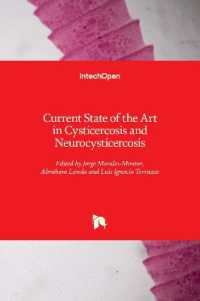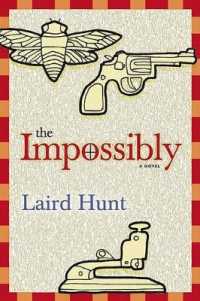- ホーム
- > 洋書
- > 英文書
- > History / World
Full Description
The Archaeology of Nucleation in the Old World explores the role of the built environment in expressing and shaping community organization and identity at prehistoric and historic nucleated settlements and early cities in the Old World. The spatial layout of large settlements results from the interaction of social, political, economic, and religious orders. Subsequent structural changes governed by the application, manipulation, and challenges of these orders yield a dynamic built environment which influences the processes of organization and identity formation. Taking advantage of advances in archaeological methods and theory that allow investigations of nucleated settlements to an extent and depth of detail that was previously impossible, the contributors to this volume address specific topics, such as how the built environment and location of activity zones help us to understand social configurations; how various scales of social units can be recognized and the resulting patterns interpreted; how collective actions contribute to settlement organization and community integrity; how changes in social relations are reflected in the development of the built environment; how cooperation and competition as well as measures to mitigate social and communication stress can be identified in the archaeological record; and how the built environment was used to express or manipulate identity.
Contents
Chapter 1: Nucleation as Social Process: Built Environment, Community Organization, and Identity.
An Introduction to the Volume - Attila Gyucha and Roderick B. Salisbury ;
Chapter 2: What Does Settlement Layout Tell Us About the Community? An Ethnoarchaeological Study - E. Nurcan Yalman ;
Chapter 3: From Sanctuaries to Towns: The Role of Religion in Early Urbanization - Manuel Fernández-Götz ;
Chapter 4: Activity Zones and Community Formation: The Role of Spatial Structure in
Early Nucleated Villages - Roderick B. Salisbury ;
Chapter 5: Population Aggregation and Social Transformations in Middle-Range Societies:
A Comparative Study of Neolithic Nucleated Settlements on the Great Hungarian Plain - Attila Gyucha ;
Chapter 6: Large Settlements of the Funnel Beaker Culture in Lesser Poland: Instruments of
Social Cohesion and Cultural Conversion - Marek Nowak, Klaus Cappenberg, Marta Korczyńska and Magdalena Moskal-del Hoyo ;
Chapter 7: Spatio-Demographic Structure and Social Organization: A Linear Trajectory or
Overlapping Trends? - Aleksandr Diachenko and Ezra B.W. Zubrow ;
Chapter 8: Sanctuaries and Settlements: Spatial Organization in the Nuragic Landscapes of
Sardinia - Ruth Beusing ;
Chapter 9: Settlement Mounds, Identity, and Continuity in the Settlement Organization of
Iron Age Jutland - Niels Haue ;
Chapter 10: Multilinear Settlement Development and Nucleation during the Early Iron Age in
Southwestern Jutland, Denmark - Niels Algreen Møller and Scott Robert Dollar ;
Chapter 11: Nucleated Settlements as Assemblages: A Regional Network Approach to
Built Environments - Francesca Fulminante ;
Chapter 12: Landscape as Metaphor: Burial Monuments and 'Landscapes of Power' in
Late Iron Age Britain - Karolis Minkevičius ;
Chapter 13: Kernavė Town in the 13th and 14th Centuries: Social and Cultural Patterns of
Community - Rokas Vengalis and Gintautas Vėlius ;
Chapter 14: The Creation and Maintenance of Powerful Places in Etruria - Simon Stoddart ;
Index








